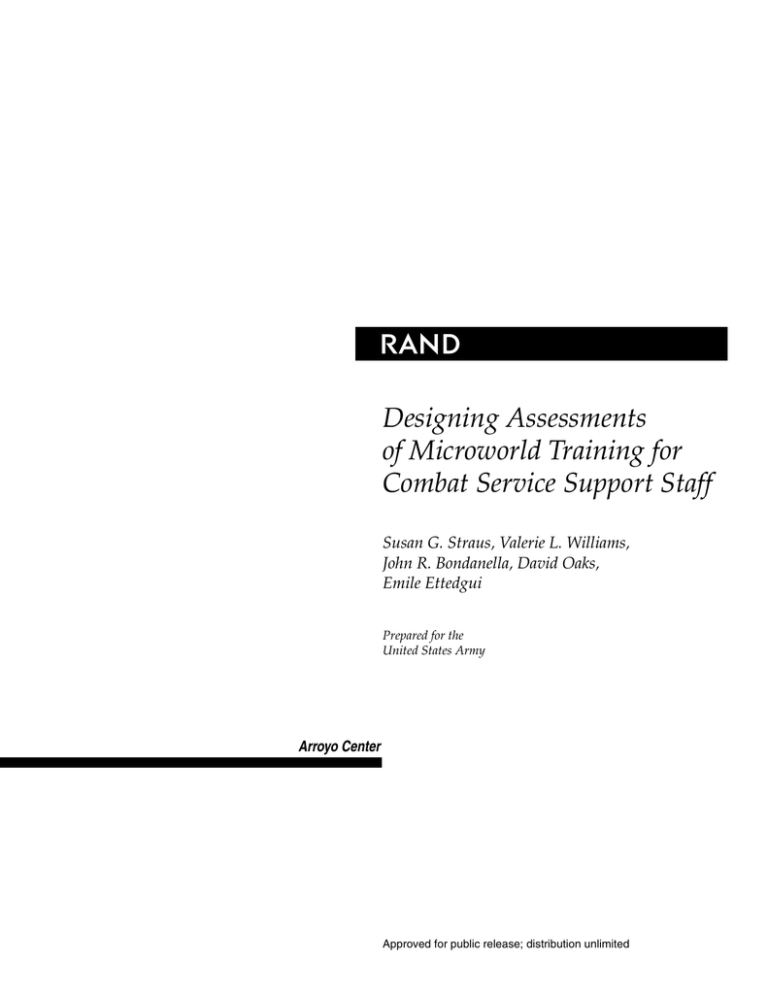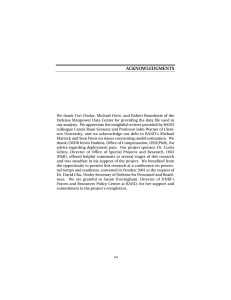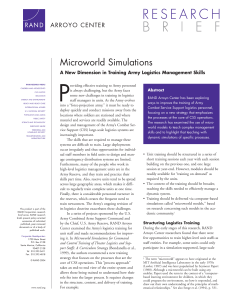
R
Designing Assessments
of Microworld Training for
Combat Service Support Staff
Susan G. Straus, Valerie L. Williams,
John R. Bondanella, David Oaks,
Emile Ettedgui
Prepared for the
United States Army
Arroyo Center
Approved for public release; distribution unlimited
The research described in this report was sponsored by the United States Army
under Contract No. DASW01-01-C-0003.
Library of Congress Cataloging-in-Publication Data
Designing assessments of microworld training for combat service support staff / Susan Straus.
p. cm.
“MR-1759.”
Includes bibliographical references.
ISBN 0-8330-3448-0 (pbk. : alk. paper)
1. United States. Army—Supplies and stores. 2. Logistics—Study and teaching—United
States—Evaluation. I. Straus, Susan.
UC263.D5 2003
355.4'11'071073—dc22
2003014993
RAND is a nonprofit institution that helps improve policy and decisionmaking
through research and analysis. RAND ® is a registered trademark. RAND’s publications do not necessarily reflect the opinions or policies of its research sponsors.
© Copyright 2003 RAND
All rights reserved. No part of this book may be reproduced in any form by any
electronic or mechanical means (including photocopying, recording, or information
storage and retrieval) without permission in writing from RAND.
Published 2003 by RAND
1700 Main Street, P.O. Box 2138, Santa Monica, CA 90407-2138
1200 South Hayes Street, Arlington, VA 22202-5050
201 North Craig Street, Suite 202, Pittsburgh, PA 15213-1516
RAND URL: http://www.rand.org/
To order RAND documents or to obtain additional information, contact Distribution
Services: Telephone: (310) 451-7002; Fax: (310) 451-6915; Email: order@rand.org
xi
Summary
We propose new methods for evaluating learning outcomes from Combat
Service Support (CSS) microworld training. RAND developed and piloted
microworld training for distribution management skills as a part of a larger
project that entailed making changes to the current structure, content, and
methods of CSS training. Microworld models are small-scale simulations of
organizations and operations. They are useful for training distribution
management processes because they give the learner an opportunity to postulate
changes and rapidly simulate the modified or new processes. Immediate
feedback helps trainees understand how their actions affect the operation and
how system components are interrelated. Consequently, trainees can learn
proactive management of assets with realistic planning horizons and develop an
understanding of the dynamic complexity affecting the organization.
We conducted pilot studies using a microworld model for U.S. Army Reserve
(USAR) soldiers in Distribution Management Centers. The degree to which
trainees learned training content was measured with a knowledge test in a
pretest-posttest design, including a control group that received only the training
and posttest. Results showed a statistically significant increase in trainees’
knowledge of distribution management processes, although the gains appeared
to be modest. The observed small increment in performance could have been
due to the content and structure of the test, which may not have fully captured
learners’ knowledge or the factors that account for learning. Consequently, we
propose a comprehensive set of evaluation measures to better assess learning and
pinpoint areas for improvement in training content and processes. In this report,
we present the following recommendations for the USAR and Combined Arms
Support Command (CASCOM): (1) use a multidimensional, objective approach
to measuring learning outcomes that includes cognitive, skill-based, and affective
measures at multiple points in time; (2) provide training and collect learning
measures via personal computer to facilitate training on demand, efficient data
collection, and rapid feedback; and (3) provide incentives for the CSS centers and
schools with responsibility for a function to help the field units develop training
and assess training effectiveness. These recommendations should have wide
application to a variety of process-oriented training programs in the field and in
the schoolhouse.







